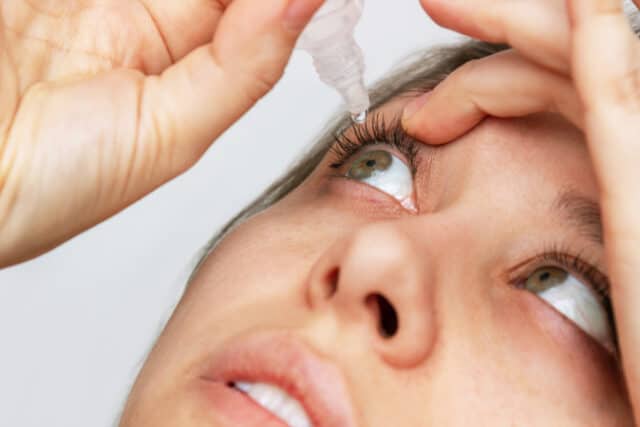
Medically reviewed by William C. Lloyd III, MD, FACS — Written by Mathieu Rees
Diabetes is a condition that can result in many complications, including dry eye. While dry eye may seem like an inconvenience, without treatment, it can lead to permanent eye damage and vision loss.
Dry eye is when a person does not produce enough quality tears to lubricate and nourish the eyes, which can cause pain and discomfort. In some cases, it can even damage the eye and result in vision loss. Dry eye can develop for many reasons, including medical conditions such as diabetes.
Diabetes is a condition that impairs the body’s ability to process blood glucose, also known as blood sugar. There are many types of diabetes, with type 1 and type 2 being the most common. Chronically elevated blood sugar levels can damage the delicate nerves that support the ocular structures, resulting in poor tear quality and decreased tear production. This can lead to the development of dry eye syndrome. Therefore, it is important for people living with diabetes to attend yearly eye screenings.
This article discusses the relationship between diabetes and dry eyes.
What is the connection?
Diabetes is a condition that can make it difficult to keep blood sugar levels within a safe range. If a person is unable to control their blood sugar, it can result in several potential health complications, including vision problems. Diabetes is a potential cause of dry eye, with some evidence suggesting that nearly half of people living with diabetes have dry eye.
Some research notes that diabetes is a leading systemic risk factor for dry eye syndrome. In fact, dry eye may occur in 15–33% of people living with diabetes over 65 years, and the risk increases with age. Similarly, a 2019 meta-analysis suggests that people with diabetes are at an increased risk of developing dry eye disease.
This is likely due to high blood sugar levels causing nerve damage to the delicate nerves that support healthy eye and eyelid function. This damage may result in a dysfunction of the lacrimal and meibomian glands, which play roles in the production and lubricating abilities of tears. As this can impact the quantity and quality of tears, it can contribute to the development of dry eye disease.
Symptoms
For dry eye syndrome, symptoms can include:
- eye pain
- a feeling of stinging, burning, or pressure within the eyes
- a sensation of eye sandiness, grittiness, or of being in contact with a foreign body
- excessive tearing, which overcompensates for dry periods
- eye redness
- blurry vision
- a sensation of having heavy eyelids
- difficulty opening the eyes
- tired eyes
Common symptoms of both type 1 and type 2 diabetes may include:
- feeling very thirsty
- frequent urination
- extreme fatigue
- blurry vision
- increase in appetite
- slow-healing wounds
- changes in weight
- tingling, pain, or numbness in the extremities
As a 2016 article explains, there are no significant differences between dry eye treatment for those with and without diabetes. However, a doctor may stress the importance of maintaining blood sugar levels in a safe range to avoid potential complications, such as eye problems. In both cases, treatment will aim to restore or maintain the normal composition and quantity of tears that continuously bathe the eye.
Typically, treatment for dry eye will involve the use of artificial tears to supplement natural tear production. Other types of treatment may include plugs, other types of eye drops, ointments, warm compresses and lid massage, or eyelid cleaners. Some people may also consider the following strategies to help reduce the risk of dry eye:
- reducing dependence on air conditioning, heating vents, or fans, which can dry out the eyes
- moving furniture or beds away from air pathways, which can also contribute to drier eyes
- using digital devices less frequently, as these encourage excessive blinking
- taking up blinking awareness training
To help maintain blood sugars within a safe range, a healthcare professional may suggest adopting lifestyle changes, which may include regular exercise, maintaining a moderate weight, quitting smoking, and following a healthy, balanced diet. In some cases, a doctor may also prescribe medications to help a person control their blood sugar.
In addition to dry eyes, diabetes can contribute to other eye problems. Notably, a common complication is diabetic retinopathy, which is the leading cause of blindness in working-age adults.
Diabetic retinopathy occurs when high blood sugar levels result in damage to blood vessels in the retina. The retina is a layer of light-sensitive cells in the back of the eye, which are essential for vision. The damaged blood vessels can leak and swell, causing vision problems.
Over time, the starving retina can stimulate the development of new, abnormal vessels that can contribute to irreversible vision loss.
Other dry eye causes
According to a 2021 paper, possible causes of dry eye syndrome can include:
- a wide range of systemic medications, from antidepressants to antihistamines
- the use of some topical medications, such as glaucoma drops
- skin problems around the eyelids, such as eczema
- eye allergies
- burns, which could be thermal or chemical
- overexposure to environmental irritants, such as pollution or cigarette smoke
- using digital devices
- eye surgery
Summary
Diabetes is a chronic condition that can result in many complications, including dry eye. If an individual is unable to control their blood sugar levels, it may result in damage to the nerves in their eyes. This can affect tear production and may result in the development of dry eye. Without treatment, dry eye can cause vision problems.
A person living with diabetes can reduce their risk of dry eye by managing their blood sugar through exercise, diet, and medications. Treatment options for dry eye typically include eye drops to help lubricate the eyes.
Republished with permission [/vc_message]












